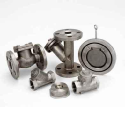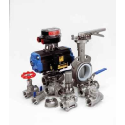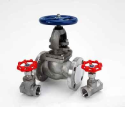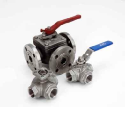T Brighton Valve Services Ltd
T Brighton Valve Services are specialist industrial valve suppliers to the UK. Based in UK and supplying industry nationwide, our expertise in pipework and flow control across different industries helps us to improve your productivity by reducing the time wasted on finding the right valve for the job.
* All Sizes, pressure ratings and materials of valves available including; cast Iron, cast steel, forged steel, stainless steel, brass, bronze and other exotic materials
* T Brighton have over 25 years experience in a wide range of valves and related industrial products
* Experience in a wide range of industries and applications
* No ties to specific manufacturers- widest choice for the customer
* Personal service- on site visits and consultation
* Philosophy of right product first, then right price
Industry loses millions of pounds each year through the consequences of improper valve selection, which can promote valve failures, resulting in loss of system fluids, out of "spec" product, downtime expenses, unsafe workplace conditions, and environmental damage.
So, for peace of mind, call the expert valve suppliers T. Brighton Valve Services now
Ball Valves
We offer a full range of ball valves in a variety of sizes, pressure ratings and materials, in wafer style, or screwed, welded or flanged connections.
The restriction on size of ball valves is only one of exponentially increasing cost of production in larger sizes (from 8” upwards) but in small to medium sizes they offer good performance for a low cost.
When selecting a ball valve, it is important to consider operating temperature and pressure, media properties, duty required and suitability for the environment
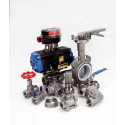
Butterfly Valves
We offer a full range of butterfly valves in a variety of sizes, pressure ratings and materials; in wafer style, lugged and tapped or fully flanged. The relatively low cost of production in medium to large sizes, and their low weight compared to gate valves makes butterfly valves a popular choice for shut off and throttling.
A butterfly valve is from the family of quarter turn valves. The "butterfly" is a metal disc mounted on a spindle. When the valve is closed, the disc is turned so that it completely blocks off the passageway. When the valve is open, the disc is rotated a quarter turn so that it allows unrestricted passage.
When selecting a butterfly valve, it is important to consider operating temperature and pressure, media properties, duty required and suitability for the environment
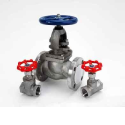
Check Valves
We offer a full range of check valves in a variety of types, sizes, pressure ratings and materials.
Also known as Non-Return Valves, A Check Valve allows fluid, liquid or gas to flow through it in only one direction. They are two-port valves, meaning they have two openings in the body, one for fluid to enter and the other for fluid to leave. Check valves work automatically and most are not controlled by a person or any external control; accordingly, most do not have any valve handle or stem. Although they are available in a wide range of sizes and designs, many check valves are small, simple, and low cost.
Some of the types of check valve we supply include:
A swing check valve is a check valve in which the disc, the movable part to block the flow, swings on a hinge or trunnion, either onto the seat to block reverse flow or off the seat to allow forward flow. This is the traditional design, and they are simple in operation. They are however, relatively large when compared to more modern designs like wafer checks. Swing checks are prone to wear at the hinge if flow is not constant (ie near a pump outlet)
A wafer check valve does not use a large body to allow the plate to swing through, but uses the pipeline itself. This significantly reduces weight and cost. The addition of springs make the valve close quicker and dampens movement in turbulent flow. Twin plate checks offer even quicker response, and do not protrude as far into the pipeline when open
A lift-check valve is a check valve in which the disc, sometimes called a lift, can be lifted up off its seat by higher pressure of inlet or upstream fluid to allow flow to the outlet or downstream side. A guide keeps motion of the disc on a vertical line, so the valve can later reseat properly. When the pressure is no longer higher, gravity or higher downstream pressure will cause the disc to lower onto its seat, shutting the valve to stop reverse flow.
A piston check is essentially a lift check valve. It has a dashpot consisting of a piston and cylinder that provides a damping effect during operation, and is therefore suitable for variable flow rates and directions.
A double check valve is often used as a backflow prevention device to keep potentially contaminated water from siphoning back into water supply lines
It is important to consider many factors in the choice of a check valve; operating temperature and pressure, media properties, orientation, turbidity of flow, frequency of operation etc
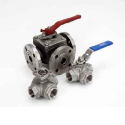
Gate Valves
We offer a full range of gate valves in a variety of types, sizes, pressure ratings and materials, with wafer type, screwed, welded or flanged connections. Gate valves are available from small to very large sizes.
Gate valves are so-named because the part that either stops or allows flow through the valve acts like a gate. The valve opens by lifting a round or rectangular wedge out of the path of the flow. Gate valves are designed to be fully opened or closed and are therefore not suitable for throttling purposes. When fully open, the typical gate valve has little or no obstruction in the flow path, resulting in very low pressure drop, and they are often suitable for hot tapping and pigging.
Gate valves are generally designed for use with the flow of liquids and gases but there are variations to cope with specific requirements. For example, one problem with wedge gate valves in steam service is that when the valve is closed and steam is brought into the system, the metal wedge expands and can get stuck, making opening the valve difficult or impossible.
Parallel slide valves are designed for use with steam, or other fluids at high temperature. A spring is fitted between the valve discs to keep them in contact with the body seat and thus allow expansion. In addition, the sliding action of the valve discs across the body seat during operation assists in removing any foreign matter such as scale that may have accumulated on the respective faces. In the closed position, positive shut off is achieved by the inlet pressure forcing the downstream disc firmly onto its respective seat. The maximum closing force therefore occurs when the isolated downstream section of the pipework is completely exhausted of pressure, i.e. when there is maximum differential pressure across the valve body. This pressure differential would typically need to be 3 or 4 bar to give satisfactory shut off.
Knife-gate valves are used when sediment may block a normal wedge gate. The gate is a narrow plate with a shaped edge to cut through solids. They are ideal for applications with a high suspension of solids or fibrous content such as powders, slurry, ash and pulp. Care should be taken when specifying knife gate valves to state whether flow is uni- or bi-directional.
Resilient seated gate valves incorporate a soft seat in the wedge to give a tighter shut off; some valves have an elastomer coated wedge to achieve this. These valves are particularly suited to gas service, provided the materials are chosen carefully.
Wedge gate valves, particularly in larger sizes, are difficult and expensive to actuate for remote operation, requiring a rotary motion to lift the gate, but parallel slides, with a lower gate mass offer less of a challenge. Knife gates can easily be pneumatically actuated, being a linear movement.
When selecting a gate valve, it is important to consider operating temperature and pressure, media properties, duty requirements, physical limitations and suitability for the environment.
Globe Valves
We offer a full range of globe valves in a variety of sizes, pressure ratings and materials.
Globe valves are linear motion valves with rounded bodies, from which their name is derived. When globe valves are open, the fluid flows through the space between the edge of the disc and the seat. These valves are widely used in industry as a fully open or fully closed on/off valve, but they may be used for throttling as long as fine adjustments are not required. Globe valves are therefore ideal to control the flow of gases such as steam. Modifications to the plug and seat profile will allow for more precise throttling, and in their most refined form are control valves.
Globe valves provide the following advantages: they offer positive shut off or throttling and control and have high pressure limits. They do not stick when closed for a period of time and do not suffer from jamming like some gate valves when subject to temperature fluctuation. Their main disadvantage is that their flow characteristics cause significant pressure drop.
Being a linear operation, and requiring a low operating force to open, globe valves can be readily actuated for remote operation.
Globe valves can be straight through, angle or oblique pattern. the oblique pattern increases the flow coefficient to reduce the pressure drop.
When selecting a globe valve, it is important to consider operating temperature and pressure, media properties, flow requirements,duty requirements, physical limitations and suitability for the environment. When installing it is vital to ensure that the valve is positioned so that the flow is from the bottom of the valve to the top.
Actuators
We offer a full range of actuated valves in a variety of types, sizes, torque ratings and materials.
TYPES OF ACTUATORS
Manual Actuators
A manual actuator employs levers, gears or wheels to facilitate movement; while an automatic actuator has an external power source to provide the force and motion to operate a valve remotely or automatically. Power actuators are a necessity on valves in pipelines located in remote areas: they are also used on valves that are frequently operated or throttled. Valves that are particularly large may be impossible or impractical to operate manually simply by the sheer horsepower requirements.
Some valves may be located in extremely hostile or toxic environments, which preclude manual operation. Additionally, as a safety feature, certain types of power actuators may be required to operate quickly, shutting down a valve in case of emergency.
Hydraulic and Pneumatic Actuators
Hydraulic and pneumatic actuators are often simple devices with a minimum of mechanical parts, used on linear or quarter-turn valves. Sufficient air or fluid pressure acts on a piston to provide thrust in a linear motion for knife gate or globe valves. Alternatively, the thrust may be mechanically converted to rotary motion to operate a quarter-turn valve. Most types of fluid power actuators can be supplied with fail-safe features to close or open a valve under emergency circumstances.
Electric Actuators
Electric actuators have a motor drive that provides torque to operate a valve. Electric actuators are frequently used on multi-turn valves such as gate or globe valves. With the addition of a quarter-turn gearbox, they can be utilized on ball, plug, or other quarter-turn valves.
Why use valve actuation?
• The use of actuated valves will allow for greater productivity.
• Provide greater safety and convenience of operation for valves underground, overhead, in remote locations, or in hazardous environments.
• Aid in precision valve timing for critical operation of automated systems.
Control Valves
We offer a full range of control valves in a variety of sizes, pressure ratings and materials.
A flow control valve regulates the flow of a fluid. Control valves normally respond to signals generated by independent devices such as flow meters or temperature gauges.
Control valves can also work with hydraulic actuators (also known as hydraulic pilots). These types of valves are also known as Automatic Control Valves. The hydraulic actuators will respond to changes of pressure or flow and will open/close the valve. Automatic Control Valves do not require an external power source, meaning that the fluid pressure is enough to open and close the valve. Automatic control valves include: pressure reducing valves, flow control valves, back-pressure sustaining valves, altitude valves, and relief valves.
An altitude valve controls the level of a tank. The altitude valve will remain open while the tank is not full and it will close when the tanks reaches its maximum level. The opening and closing of the valve requires no external power source (electric, pneumatic, or man power), it is done automatically, hence its name.
Safety Relief Valves
We offer a full range of safety relief valves in a variety of sizes, pressure ratings and materials.
The safety relief valve and pressure reducing valve are types of valve used to control or limit the pressure in a system which can build up and cause equipment failure, or fire. On a safety relief valve, the pressure is relieved by allowing the pressurised fluid to flow from an auxiliary passage out of the system.
The relief valve is designed or set to open at a predetermined pressure to protect pressure vessels and other equipment from being subjected to pressures that exceed their design limits. When the pressure setting is exceeded, the relief valve becomes the "path of least resistance" as the valve is forced open and a portion of the fluid is diverted through the auxiliary route.
The diverted gas or liquid is usually routed through a piping system or released into the atmosphere. As the flow is diverted, the pressure inside the vessel will drop. Once it reaches the valve's re-seating pressure, the valve will re-close.
Pressure reducing valves regulate the outgoing pressure at a constant preset level, even if the inlet pressure varies.

